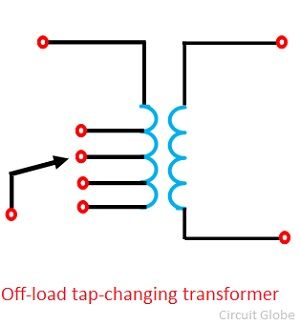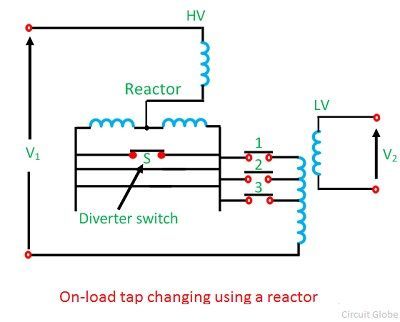The change of voltage is affected by changing the numbers of turns of the transformer provided with taps. For sufficiently close control of voltage, taps are usually provided on the high voltage windings of the transformer. There are two types of tap-changing transformers
- Off-load tap changing transformer
- On-load tap changing transformer
Off-load tap-changing transformer
In this method, the transformer is disconnected from the main supply when the tap setting is to be changed. The tap setting is usually done manually. The off load tap changing transformer is shown in the figure below
 On-load tap-changing transformer
On-load tap-changing transformer
In order that the supply may not be interrupted, on-load tap changing transformer are sued. Such a transformer is known as a tap-changing under load transformer. While tapping, two essential conditions are to be fulfilled.
- The load circuit should not be broken to avoid arcing and prevent the damage of contacts.
- No parts of the windings should be short–circuited while adjusting the tap.
 The tap changing employing a center tapped reactor R show in the figure above. Here S is the diverter switch, and 1, 2, 3 are selector switch. The transformer is in operation with switches 1 and S closed. To change to tap 2, switch S is opened, and 2 is closed. Switch 1 is then opened, and S closed to complete the tap change. It is to be noted that the diverter switch operates on load, and no current flows in the selector switches during tap changing. During the tap change only half of the reactance which limits the
The tap changing employing a center tapped reactor R show in the figure above. Here S is the diverter switch, and 1, 2, 3 are selector switch. The transformer is in operation with switches 1 and S closed. To change to tap 2, switch S is opened, and 2 is closed. Switch 1 is then opened, and S closed to complete the tap change. It is to be noted that the diverter switch operates on load, and no current flows in the selector switches during tap changing. During the tap change only half of the reactance which limits the
It is to be noted that the diverter switch operates on load, and no current flows in the selector switches during tap changing. During the tap change, only half of the reactance which limits the current is connected in the circuit.
